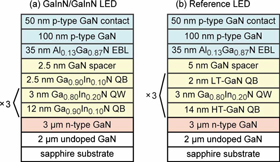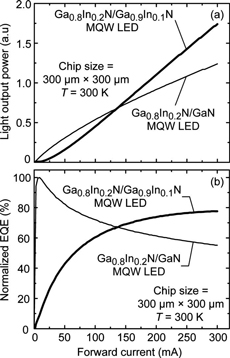
| Home | About Us | Contribute | Bookstore | Advertising | Subscribe for Free NOW! |
| News Archive | Features | Events | Recruitment | Directory |
News
23 March 2010
Reducing well/barrier polarization mismatch for higher-output LEDs
Researchers from the USA’s Rensselaer Polytechnic Institute (RPI) and South Korea’s Samsung LED and Pohang University of Science and Technology have been developing multi-quantum well (MQW) light-emitting diode using quantum barriers (QBs) made from gallium indium nitride (GaInN) rather than the usual GaN semiconductor material [Wonseok Lee et al, J. Appl. Phys., vol107, p063102, 2010]. The quantum wells were also made from GaInN, but with higher indium content to create a narrower energy bandgap compared with the barrier (Figure 1). The resulting emission wavelengths (480–443nm) were in the blue range of 490–440nm.
 Figure 1: Epi structures of GaInN/GaInN MQW LED (a) and GaInN/GaN MQW LED reference device (b).
Figure 1: Epi structures of GaInN/GaInN MQW LED (a) and GaInN/GaN MQW LED reference device (b).
One motivation for this is to reduce the piezoelectric fields that arise from the lattice-mismatch-induced strain between GaInN and GaN. There is also a spontaneous polarization electric field in nitride semiconductors such as GaInN. Electric fields across LED structures can have a number of deleterious effects on performance. For example, the field can separate the wavefunctions for electrons and holes, reducing the likelihood of light emission from their recombination. Another class of effects concerns shifts in wavelength of the emitted light at different current levels. Such color shifts are not desired either for specific-wavelength LEDs or for LEDs combined with phosphors for white-light emission with a stable color rendering index (CRI).
The researchers at RPI, under the leadership of professor E Fred Schubert, have been working with others for some time on reducing polarization effects in LEDs. In the latest reported research, they have found that the resulting reduced polarization mismatch between the wells and barriers reduced the blue-shift in emission wavelength that is normally found as the current increases (using pulsed signals with 2μsec width and 1% duty cycle to avoid self-heating effects). The forward voltage was also lower (4.1V rather than 4.6V for a reference GaInN/GaN device at 300mA), indicating better efficiency and less series resistance. The epitaxial structures also had lower pit densities in atomic force micrograph (AFM) images, which is an indicator of lower threading dislocation densities. The reverse leakage current of the devices was also reduced.
 LEDs built from the epitaxial metal-organic chemical vapor deposited (MOCVD) MQW structure on sapphire also had increased light output power (LOP) and external quantum efficiency (Figure 2). The external quantum efficiency for the new structure with GaInN QBs increased steadily with forward current, apparently saturating at about 300mA. By contrast, the traditional GaN QB reference structure showed a peak at ~10mA and a severe efficiency droop of ~45% up to 300mA.
LEDs built from the epitaxial metal-organic chemical vapor deposited (MOCVD) MQW structure on sapphire also had increased light output power (LOP) and external quantum efficiency (Figure 2). The external quantum efficiency for the new structure with GaInN QBs increased steadily with forward current, apparently saturating at about 300mA. By contrast, the traditional GaN QB reference structure showed a peak at ~10mA and a severe efficiency droop of ~45% up to 300mA.
Figure 2: Light output power (LOP, a) and normalized external quantum efficiency (EQE, b) of GaInN/GaInN MQW LED and GaInN/GaN MQW LED as function of forward current.
Simulations suggest a much reduced polarization field for the GaInN/GaInN MQW LEDs compared with those having GaN barriers (~0.8MV/cm, compared with 1.2–1.4MV/cm for forward currents of 0–300mA). In the current range 0–300mA, the reference device with GaN QBs exhibited a blue-shift from 465nm to less than 445nm. The GaInN QB LED showed a small blue-shift from ~448nm to ~444nm in the current range 0–50mA, but then the wavelength increased marginally to ~445nm in the range up to 300mA.
See related items:
Kyma and RPI search m-plane GaN for LED wavelength stability
RPI cuts LED efficiency droop via polarization-matched GaInN/GaInN MQWs
Visit: http://link.aip.org
Visit: www.rpi.edu/~schubert
The author Mike Cooke is a freelance technology journalist who has worked in the semiconductor and advanced technology sectors since 1997.